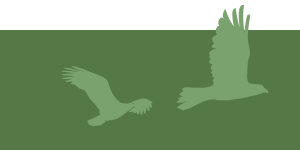
VIDEO PRESENTATIONS
To view any of these videos in full screen mode, click the expanding arrows button in the lower right corner of the small-sized video screen.
Seminario web de pretemporada de MoSI, 30 Septiembre, 2024
Better together? Integrating bioacoustic and traditional data to inform avian conservation and management. Presented by Dr. Mary Clapp
From LiDAR imagery to acoustic recording devices, biodiversity monitoring increasingly relies on remote-sensing methods and artificial intelligence to collect data at scale for use in ecological research and to inform urgent conservation efforts. However, the ability to digest, groundtruth, and utilize the resulting streams of 'Big Data' has typically required expertise in computer programming, machine learning (ML), and software development. Further, it is necessary that downstream analyses accommodate and account for inevitable false positives generated by ML models. Research that 1) bridges the gap between machine-learning outputs and biologically relevant information in a manner accessible to practicing ecologists and 2) assesses their information content relative to traditional means of data collection, is needed. In this talk, Dr. Clapp introduces an occupancy model that integrates traditional avian point count data and remotely-sensed acoustic data processed by an ML algorithm to yield estimates of bird occupancy after a prescribed fire. The model was built by an interdisciplinary team of software engineers, biostatisticians, and ecologists, with reproducibility and accessibility in mind. They find that integrating both data types yields more precise estimates of occupancy than either data type does alone. Dr. Clapp will discuss potential pitfalls and future efforts in the innovation space of integrating Big Data into ecological research.
Overwintering Performance of Nearctic-Neotropical Migratory Songbirds: An evaluation of knowledge gaps. Presented by Fabiola Rodríguez Vásquez.
This is Fabiola's PhD dissertation defense seminar for the Ecology and Evolutionary Biology Department at Tulane University. Fabiola used data from the MoSI Program (El Monitoreo de Sobrevivencia Invernal) in her dissertation research and several IBP staff members are listed as collaborators on the studies included in this dissertation. Her research is a great example of MoSI data being put to use to improve bird conservation. Congratulations Fabiola!
How and why do cloud forest bird communities respond to forest fragmentation in an Andean biodiversity hotspot? presented by Dr. Harry Jones
The cloud forests of the Tropical Andes of South America are home to a high diversity of endemic and restricted range bird species, but increasingly at risk from habitat loss. Forest loss often results in forest fragmentation, or division of remaining habitat into isolated patches of varying sizes and shapes. To better understand how cloud forest bird communities respond to fragmentation, we surveyed bird communities across a gradient of fragment patch sizes in the Western Andes of Colombia. Next, we asked which mechanisms might be driving extirpation of species from cloud forest fragments by relating avian functional traits to area sensitivity.
A Walk Through the New Edition of the ID Guide with Peter Pyle
IBP biologist Peter Pyle will walk us through the new (2nd), edition of his book The Identification Guide to North American Birds, Part 1, which is coming out in December. An important change from the first (1997) edition is the presentation of revised and consistent molt and plumage terminology, including designations of preformative molts and formative plumages, along with inclusion of "WRP" age and plumage codes (in addition to BBL age codes) that reflect this terminology. Terminology is now consistent for all North American birds treated in Parts 1 and 2. Other changes include the addition of 21 new species accounts, presentation of measurements in tables for greater ease of comparison, and inclusion of exposed culmen, tarsus, and mass values for each species and sex, and for many subspecies. Fifteen new figures have been added, many of which emphasize "molt clines" for ageing. Information has been substantially revised through evaluation of digital images, comments received from hundreds of users since 1997, and the incorporation of over 1,295 additional scientific papers and on-line resources. Finally, recognition of subspecies has been overhauled in an attempt to provide a consistent and practical taxonomy. We have learned a lot since 1997 and this revised edition reflects the progress we have all made!
"How Temperature and Elevation Shape Birds Across Geographic Space and a Changing Climate" presented by Dr. Casey Youngflesh
Understanding how the environment shapes the physical structure of species is important not only for elucidating the drivers of biodiversity, but also for predicting how species will respond to ongoing global change. Using data from more than 250,000 captures encompassing over 100 bird species from the Monitoring Avian Productivity and Survivorship (MAPS) Program, we assessed how the size and shape of birds varies across the North American continent, and how this has shifted over the past three decades. This work, enabled by the efforts of MAPS banders across North America, will serve as the basis for future exploration of the multitude of factors that drive the size and shape of birds across both space and time.
Dr. Casey Youngflesh is Quantitative Ecologist and Presidential Postdoctoral Fellow in Ecology, Evolution, and Behavior at Michigan State University. His research, broadly speaking, seeks to understand population- and community-level ecological processes across environmental gradients.
Enhancing Tribal Collaboration in the Conservation of Birds and Other Wildlife
The United States’ 574 federally-recognized Indian Tribes have jurisdiction over a vast and biologically diverse land base. In the lower 48 states, the 70 million acres that tribes own, manage, or co-manage is more than that of the National Park Service. Tribes have been recognized as sovereign entities, on a par with foreign governments, since before the founding of the U.S., a status enshrined in the constitution. Yet, tribal participation in the management of the nation’s lands and wildlife has often been ignored or minimized, and funding for tribes to manage their own resources is inadequate. It was not until the 1980s that Tribes were formally granted “permission” to manage their own wildlife populations free of state oversight. Despite these limitations, Tribes have quietly been undertaking numerous innovative management and conservation projects, many of which focus on bird conservation. Tribes also offer unique perspectives and lived experiences that are quite often missing from the current conservation dialogue. This presentation will explore the intersection of federal-state-tribal resource management, describe several examples of successful co-management, and offer suggestions for incorporating tribal values and tribal participation into national and local conservation efforts.
This webinar is presented by Dr. Serra J. Hoagland (Pueblo of Laguna) and Steven Albert M.S.. Dr. Hoagland is the National Program Lead Tribal Research for the US Forest Service. Steve Albert is IBP's Assistant Director for Demographic Monitoring Programs.
Art + Science = Scientific Illustration
In this presentation, IBP biologist and scientific illustrator Lauren Helton leads us through several of her past illustrations done for IBP's publications and outreach, and discusses some of the benefits of scientific illustration over the use of photographs. She also demonstrates some of the process she uses when creating digital artwork, offering a behind-the-scenes look at how these illustrations are made.
Translating MAPS Ageing Codes to WRP
In this presentation for bird banders, IBP's Lauren Helton reviews how to translate MAPS ageing codes to the newer, more widely applicable WRP (Wolfe-Ryder-Pyle) ageing codes. She walks viewers through several example birds.
Kiekari Bird Observatory: Nature Conservation, Research, Permaculture, and Human Reconnection
A presentation by by Alan Monroy-Ojeda of the IUCN World Commission on Protected Areas. Kiekari Bird Observatory is a bird monitoring and MoSI station located in Xico, Veracruz, Mexico, at the foothills of the Gulf of Mexico slope, along one of the most important migration corridors in the Americas. Alan Monroy is an ornithologist, natural resource management specialist, and Director of the Kiekari Bird Observatory. He is also nature illustrator, bio-builder, permaculture practitioner, and yoga enthusiast.
An Introduction to ARUs and AI
A presentation by IBP staff biologist Jerry Cole on the use of Autonomous Recording Units (ARUs) and Artificial Intelligence (AI) to monitor bird populations. Originally presented on January 31, 2022. A transcript of the chat is provided because useful information and links were shared by participants during the webinar.
Uso Del Sistema WRP En MoSI/Use of the WRP System in MoSI
Un webinar bilingüe sobre el sistema de envejecimiento del ciclo de muda WRP presentado por Peter Pyle y Ramiro Aragon Perez. A bilingual webinar on the WRP molt-cycle aging system presented by Peter Pyle and Ramiro Aragon Perez.
Long-term bird monitoring in the Maya Mountains of Belize
A presentation by Mathieu Charette, Director of the Toucan Ridge Bird Observatory (TRBO) on Dec. 13, 2021.TRBO works with both Neotropical migrants (from N. America) and austral migrants (from South America), as well as Belizean resident birds. TRBO's long-term monitoring focuses on a combination of walking transects, point-count surveys, citizen science programs (such as eBird), and bird banding, often through the MoSI program. TRBO also investigates migratory connectivity through the MOTUS initiative. Here Mathieu presents the results of 9 yrs of bird banding at T.R.B.O. and information about the development of a bird banding culture and capacity building in Belizean bird banders and the evolution of a National Belize Bird Banding lab.
Bumble Bee Ecology and Conservation in the Sierra Nevada
Presented by IBP Biologist and Meadow Specialist Helen Loffland on November 30th, 2021. A review of basic bumble bee ecology and some of the research IBP is doing to help conserve these native insects in the Sierra Nevada region.
Banding on the Pitaya Coast: Monitoring a coastal thornscrub forest & reflections on developing migration research with limited resources
A presentation by Mike Krzywicki on October 21, 2021. Mike Krzywicki is an ornithologist working in western North America. He studies breeding and migratory songbirds in Montana, USA as an Avian Ecologist at the University of Montana Bird Ecology Lab, and wintering birds in Sonora, Mexico as Director of Navopatia Field Station. This the third in a webinar series on bird monitoring, bird banding and demographics co-sponsored by the Western Bird Banding Association and IBP.
Adventures in Bird Molt: Finding fun in a forbidding yet fundamental process
A presentation by Peter Pyle on September 30th, 2021. Learning how to identify feather generations and use this information to age birds can be intimidating! In this webinar, Peter Pyle walks us through the who, what, where, why, and when of molt, and why molt is so important for biologists to understand.
Meadows in the Sierra Nevada: restoration implications for birds and bumble bees.
A presentation by Helen Loffland for the 45th Annual Western Field Ornithologists Conference, August 26–29, 2021.
Examination of digital images from the Macaulay Library to determine avian molt strategies: A case study on molts and plumages in eight species of western North American hummingbirds.
A presentation by Peter Pyle for the 45th Annual Western Field Ornithologists Conference, August 26–29, 2021.
The Bird Genoscape Project in Latin America: Where Are We, and Where Are We Going?
A presentation by Rafael Rueda Hernandez coordinator of the Bird Genoscape Project in Mexico and IBP partner in the MoSI and MAPS programs. This the second in a webinar series on bird monitoring, bird banding and demographics co-sponsored by the Western Bird Banding Association and IBP.
The Challenges and Opportunities of Bird Banding and Demographic Research in Ecuador
A presentation by Nicole Büttner of Un poco del Chocó. This the first in a webinar series on bird monitoring, bird banding and demographics co-sponsored by the Western Bird Banding Association and IBP.
MoSI: Birds Connecting the Americas
A short film by Day's Edge Productions about MoSI, a program coordinated by The Institute for Bird Populations. MoSI is a collaborative, international network of bird monitoring stations across the northern Neotropics that bolsters conservation efforts through population monitoring.
Demystifying Molt with Dani Kaschube
hosted by Nate Swick
An excerpt from the September 2, 2021 episode of the American Birding Association's podcast.
Diversity, trends, phenology, and demography of a subalpine breeding bird community in relation to climate variation.
by David F. DeSante and James F. Saracco
A scientific presentation by James F. Saracco for the 68th meeting of The Wildlife Society- Western Section Feb. 1-5, 2021.
Customizing Methodologies in Monitoring Bird Populations to Suit Local Installation Needs.
by Steven K. Albert, Chris Ray, Jessie Schillaci, Andrew Satterwhite, Danielle Kaschube, and Lynn Schofield.
A scientific presentation by Steven Albert for the 2021 National Military Fish and Wildlife Association Conference, March 8-12, 2021.
Burning issues in a dynamic environment: effects of the Sierra Nevada's changing fire regime on priority bird species.
A scientific presentation by Rodney Siegel for the 68th meeting of The Wildlife Society- Western Section Feb. 1-5, 2021.
Evaluating and optimizing a comprehensive multi-species bird sound classifier.
by Jerry Cole, Nichole Michel, Shane Emerson and Rodney Siegel.
A scientific presentation by Jerry Cole for the 68th meeting of The Wildlife Society- Western Section Feb. 1-5, 2021.
Basics of Passerine Molt: Theory and Examples
IBP's MAPS program coordinator Dani Kaschube's 2020 webinar on molt for the Western Bird Banding Association. The webinar focuses on molt in passerine birds (songbirds), beginning with basics and theory of molt and moving on to specific cases studies for bird banders. If you have been intimidated by the study of molt in the past, Dani’s presentation is a great introduction to the subject-she starts at the beginning, and breaks down the topic into easy-to-follow steps.
Assessing vulnerabilities in the mutualism between whitebark pine and Clark's Nutcracker
by Chris Ray, Regina M. Rochefort, Jason I. Ransom, Jonathan C.B. Nesmith, Sylvia A. Haultain, Taza D. Schaming, John R. Boetsch, Mandy L. Holmgren, Robert L. Wilkerson, and Rodney Siegel.
A scientific presentation by Dr. Chris Ray for the North American Congress for Conservation Biology in July 2020 and the 68th meeting of The Wildlife Society- Western Section Feb. 1-5, 2021.








